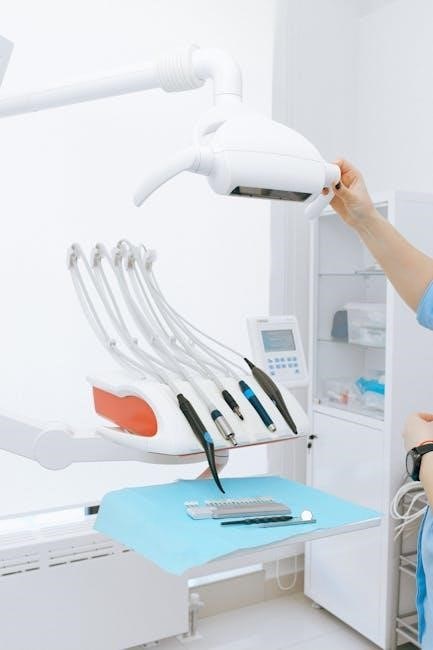A comprehensive guide for dental professionals, the Dental Handbook PDF offers detailed insights into various dental practices, procedures, and ethical considerations, serving as an essential resource for dentists and students.
Overview of Dental Handbook PDF
The Dental Handbook PDF is a comprehensive resource designed for dental professionals, offering detailed insights into various aspects of dentistry. It serves as a practical guide, covering essential topics such as dental anatomy, common procedures, preventive care, and modern technologies. The handbook is regularly updated to reflect advancements in the field, ensuring practitioners stay informed about the latest techniques and evidence-based practices. It is intended for both experienced dentists and students, providing a concise yet thorough overview of clinical and ethical considerations. With contributions from experts, the handbook emphasizes patient care, communication, and ethical decision-making, making it an indispensable tool for enhancing professional skills and delivering high-quality dental services.
Importance of Dental Handbooks for Practitioners
Dental handbooks are indispensable tools for practitioners, providing quick access to evidence-based guidelines and practical insights. These resources help dentists stay updated on the latest techniques, materials, and technologies, ensuring they deliver high-quality care. By offering clear, concise information, handbooks enhance clinical decision-making and improve patient outcomes. They serve as valuable references for both routine procedures and complex cases, aiding in diagnosis, treatment planning, and patient communication. Additionally, handbooks often include ethical considerations and professional standards, supporting dentists in maintaining integrity and compliance. Regular use of dental handbooks fosters continuous professional development, enabling practitioners to adapt to evolving dental practices and provide optimal care in diverse clinical settings.
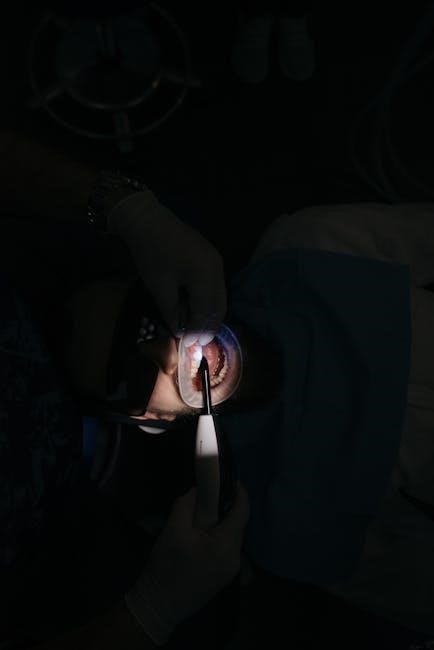
Essential Topics Covered in Dental Handbooks
Dental handbooks cover essential topics like dental anatomy, procedures, preventive care, restorative techniques, orthodontics, and digital tools, ensuring comprehensive guidance for dental practitioners.
Dental Anatomy and Physiology

Dental anatomy and physiology form the foundation of understanding oral health, focusing on the structure and function of teeth, gums, and surrounding tissues. This section details the morphology of permanent and primary teeth, including classifications based on shape and function. It also explores the supportive structures like the periodontium and jawbones, essential for mastication and overall oral stability. The handbook explains the nervous and vascular supply of the oral cavity, highlighting their roles in sensation and tissue nutrition. Additionally, it covers the processes of tooth development, enamel formation, and the role of saliva in maintaining oral pH balance. This knowledge is crucial for diagnosing and treating dental conditions, ensuring a comprehensive approach to patient care.
Common Dental Procedures and Techniques
Common dental procedures and techniques are essential for maintaining oral health and addressing various dental issues. These include routine cleanings, fillings, and extractions, which are fundamental for preventing and treating tooth decay. Scaling and polishing are emphasized to remove plaque and tartar, ensuring gum health. Restorative techniques like crowns and bridges are detailed, providing solutions for damaged or missing teeth. The handbook also covers root canal treatments and dental implants, offering insights into advanced procedures. Modern methods, such as digital impressions and laser dentistry, are highlighted for their precision and patient comfort. These procedures are complemented by preventive measures, including fluoride applications and sealants, to promote long-term oral well-being. Staying updated on these techniques is crucial for effective patient care.
Preventive Dental Care and Hygiene
Preventive dental care and hygiene are cornerstone concepts in maintaining optimal oral health. This section emphasizes the importance of regular brushing, flossing, and dental check-ups to prevent common issues like tooth decay and gum disease. Fluoride treatments and dental sealants are highlighted as effective preventive measures, particularly for children. The handbook also explores the role of diet in oral health, advising on sugar reduction and nutrient-rich choices. Professional cleanings and personalized hygiene plans are discussed to tailor care to individual needs. By focusing on prevention, patients can avoid more invasive treatments and maintain a healthy, confident smile throughout their lives. These practices are foundational for long-term dental well-being and overall health.
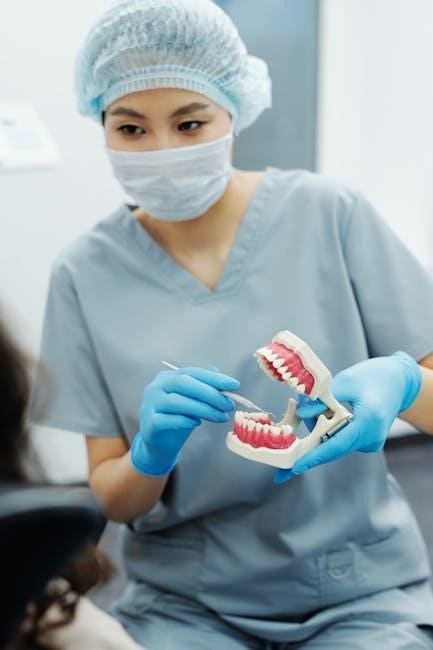
Restorative Dentistry in Dental Handbooks
Restorative dentistry focuses on repairing and replacing damaged teeth, addressing decay, and restoring function. Techniques include fillings, crowns, bridges, and implants, ensuring optimal oral health and aesthetics.
Fillings and Restorations
Fillings and restorations are fundamental in restorative dentistry, aimed at repairing teeth damaged by decay or trauma. Dental handbooks detail various materials, such as amalgam, composite resin, and newer biocompatible options, emphasizing their durability and aesthetic properties. The choice of material depends on factors like tooth location, patient preferences, and cost. Proper techniques for cavity preparation and restoration placement are highlighted, ensuring long-term functionality and oral health. These procedures are essential for preserving tooth structure, preventing further decay, and restoring chewing efficiency. Handbooks also address modern advancements, such as adhesive dentistry and minimally invasive approaches, providing evidence-based guidance for dentists to achieve optimal outcomes.
Crowns and Bridges
Crowns and bridges are essential restorative solutions for severely damaged or missing teeth. Dental handbooks detail their use in restoring function and aesthetics, with materials like ceramic, porcelain, and metal alloys offering durability and natural appearance. The handbook guides practitioners through impression-taking, temporary restorations, and final cementation, emphasizing precise fit and occlusal harmony. Bridges, either fixed or removable, address tooth loss, while crowns protect weakened teeth. Modern techniques, including digital impressions and CAD/CAM systems, enhance accuracy and patient satisfaction. Proper planning and execution ensure long-term success, making crowns and bridges indispensable in comprehensive dental care, as highlighted in resources like the Oxford Handbook of Clinical Dentistry.
Dental Implants and Prosthetics
Dental implants and prosthetics are advanced solutions for tooth replacement, offering durability and natural aesthetics. Handbooks detail patient evaluation, biomechanical considerations, and surgical techniques for successful implant placement. Prosthetics, including fixed and removable options, restore function and confidence. Modern materials like titanium and zirconia ensure compatibility and longevity. The process involves precise planning, implant integration, and prosthetic fabrication. Long-term maintenance and patient care are emphasized to ensure optimal outcomes. These treatments bridge the gap between restorative and cosmetic dentistry, providing patients with reliable, long-lasting solutions. The Oxford Handbook of Clinical Dentistry and other guides offer in-depth insights into these procedures, making them invaluable for practitioners and students alike in mastering implantology and prosthetic rehabilitation.
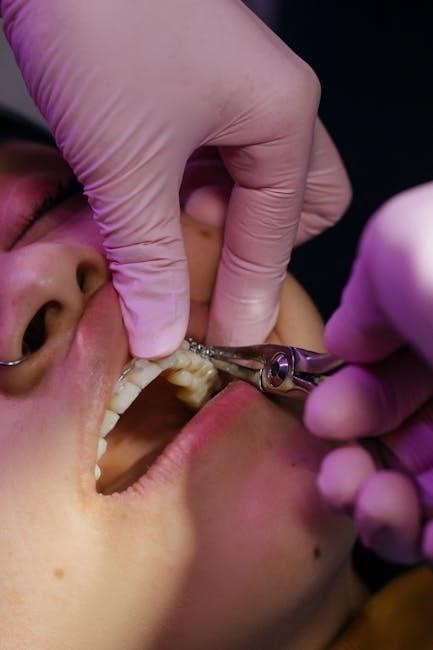
Orthodontics and Pediatric Dentistry
This section covers orthodontic diagnosis, treatment planning, and pediatric dental care. It includes growth modification, interceptive orthodontics, and managing child behavior, ensuring comprehensive care for young patients.
Orthodontic Diagnosis and Treatment
Orthodontic diagnosis and treatment involve a comprehensive evaluation of dental and facial irregularities to create personalized care plans. Early assessment of malocclusions, such as overbites or crowding, is crucial for effective intervention. Treatment options include braces, aligners, and functional appliances, tailored to address specific needs. Growth modification techniques are often used in pediatric cases to guide jaw development. This section emphasizes the importance of accurate diagnosis, treatment timing, and patient compliance for successful outcomes. It also explores interceptive orthodontics to prevent severe issues later. Detailed case studies and clinical tips provide practical insights, ensuring optimal results for patients of all ages.
Pediatric Dental Care and Management
Pediatric dental care focuses on the unique oral health needs of children, from infancy through adolescence. Early dental visits are crucial for preventing tooth decay and promoting healthy habits. The handbook provides guidance on behavior management techniques to make dental experiences positive for young patients. It includes recommendations for fluoride therapy, dental sealants, and nutrition counseling to prevent caries. Special attention is given to managing anxiety and fear, ensuring children receive timely and effective care. This section also covers developmental milestones, such as teething and mixed dentition, offering practical tips for parents and practitioners. By addressing these aspects, the handbook equips dentists with the tools to deliver compassionate and comprehensive care tailored to children’s needs.
Prosthodontics and Cosmetic Dentistry
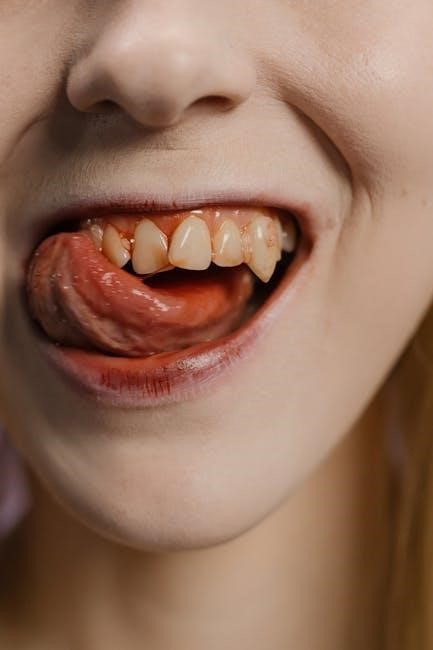
This section covers advanced techniques in prosthodontics and cosmetic dentistry, focusing on restoring function and aesthetics through implants, veneers, and modern materials for enhanced patient outcomes.
Prosthetic Rehabilitation
Prosthetic rehabilitation focuses on restoring oral function, aesthetics, and comfort through custom-designed prosthetics. This includes crowns, bridges, dentures, and implants, tailored to individual patient needs. Advanced materials like ceramic and zirconia are highlighted for durability and natural appearance. The handbook provides step-by-step guides for impression-taking, prosthetic design, and fitting, ensuring optimal outcomes. It also addresses challenges such as occlusal harmony and patient adaptation. Prosthetic rehabilitation is essential for patients with missing or damaged teeth, offering a comprehensive solution to regain chewing ability and confidence. The section emphasizes evidence-based practices and interdisciplinary approaches, making it a valuable resource for both clinicians and students in achieving successful prosthetic outcomes.
esthetic Considerations in Dental Restorations
Esthetic Considerations in Dental Restorations
Esthetic considerations in dental restorations are crucial for achieving natural-looking results that enhance patient satisfaction. The handbook emphasizes the importance of color matching, shape, and texture to blend restorations with surrounding teeth. Modern materials, such as ceramic and composite resins, are highlighted for their ability to mimic natural tooth aesthetics. Clinical photography is recommended for documentation and communication with laboratories. The section also covers smile design principles, ensuring restorations align with facial aesthetics. Patient expectations and psychological factors are addressed, stressing the need for clear communication. By balancing functionality with esthetics, dentists can deliver restorations that not only restore oral health but also boost confidence and overall well-being. This approach ensures a harmonious and visually pleasing outcome for patients.
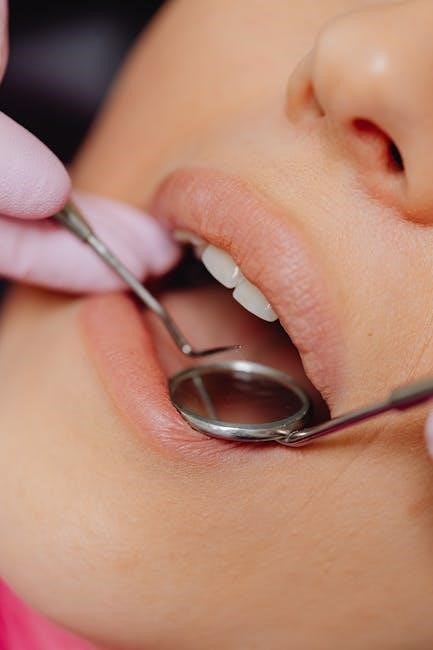
Digital Dentistry and Modern Tools
Digital dentistry integrates advanced technologies like CAD/CAM systems, intraoral scanners, and 3D printing, enhancing precision and efficiency in dental procedures and restorations, as detailed in the handbook.
Role of Digital Technology in Dentistry
Digital technology has revolutionized dentistry, enhancing precision, efficiency, and patient outcomes. Tools like CAD/CAM systems, intraoral scanners, and 3D printing enable accurate restorations and prosthetics. Clinical photography aids in documentation and diagnosis, while digital impressions streamline treatment planning. These advancements integrate seamlessly with modern dental practices, offering evidence-based solutions. The handbook highlights how digital tools improve communication between professionals and patients, ensuring personalized care. By adopting these technologies, dentists can deliver high-quality, esthetically pleasing results, making digital dentistry indispensable in contemporary practice.
Clinical Photography and Documentation
Clinical photography and documentation are essential tools in modern dentistry, providing detailed records for diagnosis, treatment planning, and patient communication. High-quality images capture dental anatomy, restorations, and pathological conditions, aiding in precise documentation. Advances in digital technology have enhanced image clarity and storage, making it easier to track treatment progress. These visuals also serve as valuable teaching aids for dental education. Proper documentation ensures accountability and legal protection for both dentists and patients. The handbook emphasizes the importance of standardized protocols for clinical photography to maintain consistency and accuracy in dental practices. By integrating photography into routine care, dentists can improve diagnostic accuracy and enhance patient outcomes, making it a cornerstone of contemporary dental workflows. This section highlights best practices for capturing and utilizing clinical images effectively.

Dental Emergencies and Pain Management
Dental emergencies require prompt attention to alleviate pain and prevent complications. This section outlines diagnosis, treatment, and patient care strategies for urgent dental issues, ensuring effective pain management and optimal outcomes.
Common Dental Emergencies
Common dental emergencies include severe toothaches, broken or knocked-out teeth, lost fillings, abscesses, and gum injuries; These situations require immediate attention to prevent further damage or infection. A toothache may indicate a deep cavity or pulp infection, while a broken tooth can expose sensitive nerves. Lost fillings or crowns leave teeth vulnerable to decay or fracture. Abscesses, often causing swelling and pain, are infections that may require drainage or antibiotics. Gum injuries, such as lacerations, can bleed heavily and may need professional care. In such cases, rinsing with warm water, applying a cold compress, or using temporary fillers can provide temporary relief. Prompt consultation with a dentist is crucial to address these issues effectively and prevent long-term complications.
Pain Management and Anesthesia
Pain management and anesthesia are critical components of dental care, ensuring patient comfort during procedures. Local anesthesia, such as lidocaine or articaine, is commonly used to numb specific areas, preventing pain during treatments like fillings or extractions. Topical anesthetics may also be applied to minimize discomfort before injections. For anxious patients, sedation techniques like nitrous oxide or oral sedation can provide relaxation. Effective pain management is tailored to individual needs, balancing efficacy with safety. Proper administration and monitoring are essential to avoid complications, ensuring a positive experience for patients. Dental handbooks provide detailed protocols for anesthesia and pain relief, emphasizing evidence-based practices for optimal outcomes.

Ethics and Patient Care in Dentistry
Ethical principles guide dentists to prioritize patient well-being, ensuring informed consent and confidentiality. Effective communication fosters trust, while respecting patient autonomy remains central to compassionate care;
Ethical Considerations for Dentists
Ethical considerations in dentistry are fundamental to ensuring patient-centered care. Dentists must uphold principles such as respect for autonomy, beneficence, non-maleficence, and justice. Confidentiality and informed consent are critical, requiring clear communication about treatment options and risks. The American College of Dentists emphasizes ethical conduct as a cornerstone of professional integrity. Dentists must balance patient needs with societal expectations, avoiding conflicts of interest. The Oxford Handbook of Dental Patient Care and other resources provide guidance on navigating ethical dilemmas. Adherence to ethical standards fosters trust and ensures equitable care. Continuous education and self-reflection help dentists stay aligned with evolving ethical practices and patient expectations in modern dentistry.
Patient Communication and Consent
Effective patient communication is vital for obtaining informed consent, ensuring patients understand their treatment options and associated risks. Dentists must communicate clearly, using accessible language to address patient concerns and preferences. The Oxford Handbook of Dental Patient Care highlights the importance of empathy and active listening in building trust. Written and verbal consent must be documented, with patients fully understanding their rights and responsibilities. Special considerations apply to pediatric and vulnerable populations, requiring tailored communication strategies. Open dialogue fosters mutual understanding, ensuring ethical and legal standards are met. These practices are detailed in resources like the Handbook on Paediatric Dentistry, emphasizing the need for clear and compassionate communication in all patient interactions. This approach ensures care is patient-centered and respectful, aligning with professional guidelines and ethical standards in dentistry.

Resources and Further Reading
The Oxford Handbook of Clinical Dentistry and specialized guides like Crown and Bridge Prosthodontics offer in-depth knowledge. Online platforms provide updated resources and evidence-based dental practices for professionals.
Recommended Dental Handbooks and Guides
Several dental handbooks are highly recommended for practitioners, including the Oxford American Handbook of Clinical Dentistry, known for its concise and practical approach to various dental procedures and patient care. Another essential resource is the Crown and Bridge Prosthodontics ⎼ An Illustrated Handbook, which provides detailed insights into restorative techniques. Additionally, the Paediatric Dentistry Handbook offers comprehensive guidance on managing dental care for children. These handbooks are designed to complement clinical experience, offering evidence-based recommendations and modern techniques. They serve as invaluable tools for both dental students and experienced professionals, ensuring they stay updated with the latest advancements in dentistry.
Online Resources for Dental Professionals
Digital platforms offer a wealth of resources for dental professionals, enhancing their knowledge and practice. Websites like the American Dental Association (ADA) and American Academy of Pediatric Dentistry (AAPD) provide access to clinical guidelines, research articles, and educational materials. Additionally, online libraries and databases, such as PubMed, offer extensive collections of dental journals and case studies. Many dental schools and professional organizations also publish free or subscription-based resources, including webinars and downloadable PDF guides. These online tools enable dentists to stay updated on advancements, refine their techniques, and improve patient care. They are invaluable for both ongoing education and clinical decision-making.
